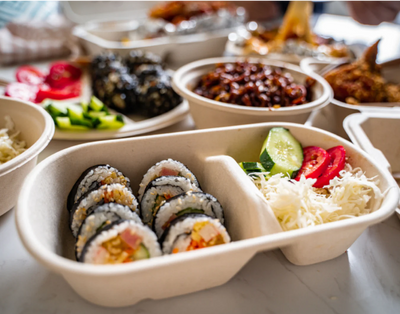While out to a restaurant, a grocery store, a fast-food establishment, or a bar, you might’ve noticed an influx in eco-friendly straws, or maybe you aren’t offered a straw at all. If you ask, you’re probably told some hurried, vague explanation involving the environment, specific legislature, and the ocean. You got some information, but not really enough to go on, right? There’s more to it than just laws and environmentalists, so let’s get into the many problems and disadvantages of plastic straws.
>>> Read more:
- What Are Plastic Straws? Pros, Cons - Hazards, Bans, Recycling
- 10 best eco-friendly & reusable straws for a better environment
- Not-paper straws: 7 best biodegradable straws for our environment
- Compostable vs. reusable straws: which one is the best eco-friendly alternative
- What are biodegradable straws made of?
- PFAS: What they are, how they are classified and why they are harmful
Stats On Plastic Straws
Australian scientists estimate that there are approximately 7.5 million plastic straws just polluting the U.S shorelines, and anywhere from 437 million and 8.3 billion plastic straws cluttering shorelines across the globe. That seems excessive, right?But then, plastic straws are just a small fraction of the 8 million metric tons of plastic that goes into the ocean each year. Straws are an even smaller fraction of the 2.5 billion metric tons of waste that are produced around the world. See how it all adds up?
According to this other infographic, about 500,000 plastic straws are used daily. Plus, they estimated that 100,000 marine animals die due to plastic debris in their ecosystem.
Even with those stats, according to a beach cleanup volunteer organization, straws were the seventh most common piece of trash found in 2018. Seventh most. That’s following cigarette butts, food wrappers, plastic bottles, plastic bottle caps, plastic grocery bags, and other plastic bags such as garbage sacks. They claim that there are enough straws found on the beaches to reach the height of 10,000 palm trees and that the total weight of the trash is equal to about 812 anchors.
Deep Dive Into The Two Main Dangers Of Plastic Straws
Those stats are pretty shocking, and almost hard to visualize. But stats aren’t everything, as there are more things to consider when weighing what you’re going to do about the straw problem in your own life.PLASTIC STRAWS CAN’T BE BROKEN DOWN BY NATURE.
The plastic that’s used to make straws is typically too light to be noticed or caught by mechanical garbage sorters. They’ll often slip through the sorting screens and get caught up with other materials, ultimately ending up in the oceans or landfills as garbage rather than filtered and recycled. Then, they do tend to deteriorate into microplastics, cluttering the environments in question, which means that the plants and wildlife could absorb the microplastics through eating and drinking. You wouldn’t want your house pet eating plastic in their food, so why should wild animals be considered any different?

PLASTIC STRAWS PRODUCTION INCREASES EMISSIONS.
Go back to the statistics for a second and recall just how many straws are used daily. That’s a lot of plastic straw production to meet that quota, let alone extra straws that aren’t in use, and precautions to ensure that there isn’t a straw shortage. Plastic straws are single-use, and they usually come in packs of 10 or more, so that’s billions of unused straws sitting and waiting to be a part of the 500,000 straws that are used daily.
Coal plants produce about 26% of global greenhouse gas emissions, doubling that of transportation, according to Climate Central. And according to this report by the Center for International Environmental Law, the production and disposal of single-use plastics in 2019 caused the equivalent emissions of 189 coal plants, and by 2030 that number could rise to 295. That means the percentage of emissions is on the climb rather than the decline, which generally doesn’t look good for our future planet.
Single-use plastics such as straws are a prime example of overall poor waste management systems that are pretty unmanageable from an environmental perspective. The continued supply and demand for such products that harm several different ecosystems and species could easily be propagated differently through reusable and/or disposable straws.

Be Conscious Of What You Consume - Buy Reusable Where You Can
The bottom line is that single-use plastic straws are bad for the environment and should be phased out. Going reusable with straws is a simple, yet effective means to reduce your personal carbon footprint. The same applies if you use some sort of biodegradable straw at a small business, cafe, or restaurant.
EQUO International is all about the planet, and our goal is to create eco-friendly products that you can use to replace some of the most harmful plasticware seen in everyday life. Our biodegradable compostable straws are the first step toward sustainability, and they’re not only reusable in some cases, but they can perform the same tasks as a traditional plastic straw without major differences that you’d find in glass, metal, or rubber straws. We want our offerings to seamlessly take the place of the plastic offenders, so you don’t think twice about your decision to leave single-use plastic behind.
Tags: biodegradable straws, compostable straws, buy biodegradable straws, where to buy biodegradable straws, plasticless straws, organic straws, eco friendly biodegradable straws, grass straws, grass straw, coffee straws, coffee straw, plant-based compostable straws, compostable drinking straws, eco compostable straws, compostable straw


